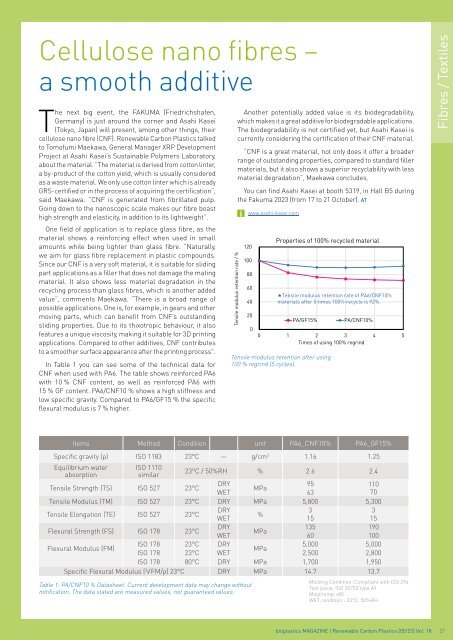Issue 05/2023
Highlights Fibres / Textiles Polyurethane / Elastomers
Highlights
Fibres / Textiles
Polyurethane / Elastomers
You also want an ePaper? Increase the reach of your titles
YUMPU automatically turns print PDFs into web optimized ePapers that Google loves.
Cellulose nano fibres –<br />
a smooth additive<br />
The next big event, the FAKUMA (Friedrichshafen,<br />
Germany) is just around the corner and Asahi Kasei<br />
(Tokyo, Japan) will present, among other things, their<br />
cellulose nano fibre (CNF). Renewable Carbon Plastics talked<br />
to Tomofumi Maekawa, General Manager XRP Development<br />
Project at Asahi Kasei’s Sustainable Polymers Laboratory,<br />
about the material. “The material is derived from cotton linter,<br />
a by-product of the cotton yield, which is usually considered<br />
as a waste material. We only use cotton linter which is already<br />
GRS-certified or in the process of acquiring the certification”,<br />
said Maekawa. “CNF is generated from fibrillated pulp.<br />
Going down to the nanoscopic scale makes our fibre boast<br />
high strength and elasticity, in addition to its lightweight”.<br />
One field of application is to replace glass fibre, as the<br />
material shows a reinforcing effect when used in small<br />
amounts while being lighter than glass fibre. “Naturally,<br />
we aim for glass fibre replacement in plastic compounds.<br />
Since our CNF is a very soft material, it is suitable for sliding<br />
part applications as a filler that does not damage the mating<br />
material. It also shows less material degradation in the<br />
recycling process than glass fibres, which is another added<br />
value”, comments Maekawa. “There is a broad range of<br />
possible applications. One is, for example, in gears and other<br />
moving parts, which can benefit from CNF’s outstanding<br />
sliding properties. Due to its thixotropic behaviour, it also<br />
features a unique viscosity, making it suitable for 3D printing<br />
applications. Compared to other additives, CNF contributes<br />
to a smoother surface appearance after the printing process”.<br />
In Table 1 you can see some of the technical data for<br />
CNF when used with PA6. The table shows reinforced PA6<br />
with 10 % CNF content, as well as reinforced PA6 with<br />
15 % GF content. PA6/CNF10 % shows a high stiffness and<br />
low specific gravity. Compared to PA6/GF15 % the specific<br />
flexural modulus is 7 % higher.<br />
Tensile modulus retention rate / %<br />
Another potentially added value is its biodegradability,<br />
which makes it a great additive for biodegradable applications.<br />
The biodegradability is not certified yet, but Asahi Kasei is<br />
currently considering the certification of their CNF material.<br />
“CNF is a great material, not only does it offer a broader<br />
range of outstanding properties, compared to standard filler<br />
materials, but it also shows a superior recyclability with less<br />
material degradation”, Maekawa concludes.<br />
You can find Asahi Kasei at booth 5319, in Hall B5 during<br />
the Fakuma <strong>2023</strong> (from 17 to 21 October). AT<br />
120<br />
100<br />
www.asahi-kasei.com<br />
80<br />
60<br />
40<br />
20<br />
0<br />
Properties of 100% recycled material<br />
★Tensile modulus retention rate of PA6/CNF10%<br />
materials after 5 times 100% recycle is 92%.<br />
PA/GF15%<br />
Tensile modulus retention after using<br />
100 % regrind (5 cycles).<br />
PA/CNF10%<br />
0 1 2 3 4 5<br />
Times of using 100% regrind<br />
Fibres / Textiles<br />
Items Method Condition unit PA6_CNF10% PA6_GF15%<br />
Specific gravity (ρ) ISO 1183 23°C ― g/cm 3 1.16 1.25<br />
Equilibrium water<br />
absorption<br />
ISO 1110<br />
similar<br />
Table 1: PA/CNF10 % Datasheet. Current development data may change without<br />
notification. The data stated are measured values, not guaranteed values.<br />
23°C / 50%RH % 2.6 2.4<br />
Tensile Strength (TS) ISO 527 23°C<br />
DRY<br />
95 110<br />
MPa<br />
WET 63<br />
70<br />
Tensile Modulus (TM) ISO 527 23°C DRY MPa 5,800 5,300<br />
Tensile Elongation (TE) ISO 527 23°C<br />
DRY<br />
3 3<br />
%<br />
WET 15 15<br />
Flexural Strength (FS) ISO 178 23°C<br />
DRY<br />
135 190<br />
MPa<br />
WET 60 100<br />
Flexural Modulus (FM)<br />
ISO 178 23°C DRY<br />
5,000 5,000<br />
MPa<br />
ISO 178 23°C WET 2,500 2,800<br />
ISO 178 80°C DRY MPa 1,700 1,950<br />
Specific Flexural Modulus ( 3 √FM/ρ) 23°C DRY MPa 14.7 13.7<br />
Molding Condition: Compliant with ISO 294<br />
Test piece: ISO 20753 type A1<br />
Mold temp.=80<br />
WET condition : 23°C, 50%RH<br />
bioplastics MAGAZINE | Renewable Carbon Plastics [<strong>05</strong>/23] Vol. 18<br />
27

















